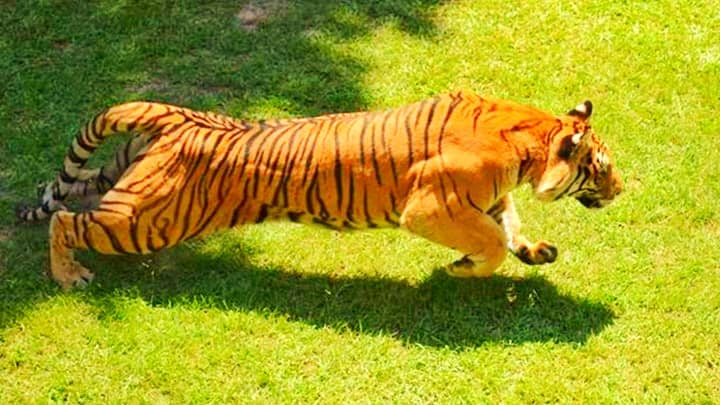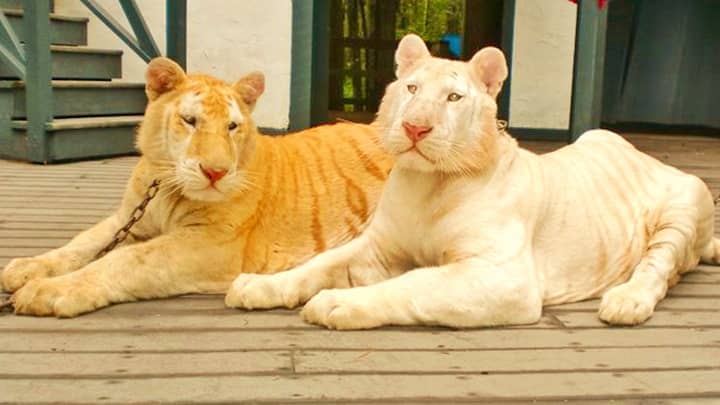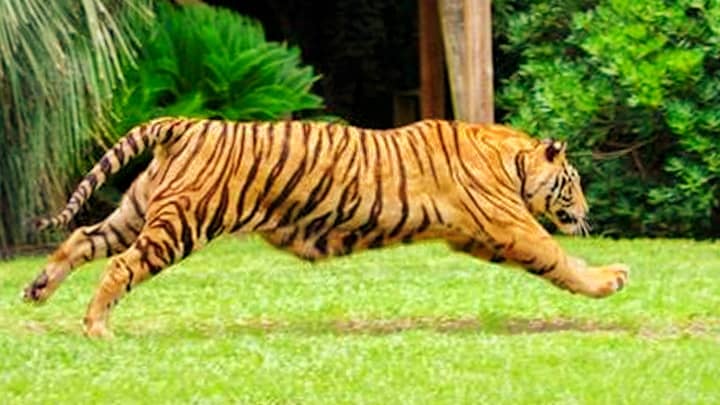Tiger Stripes - 10 Facts
Tigers, the crown kings of forest posses beautiful stripes on their fur. In fact; the tigers' stripes serve as their key and striking feature of recognition. Whenever; a person watches a big cat with stripes on its fur, it quickly recognizes it as a tiger. You may confuse a leopard with a jaguar or a lion with a puma but you can't confuse a tiger with any other big cat because a tiger has stripes which the other cats don't.
Tigers are recognized through the stripes on their fur. These stripes of the tigers have a lot of facts and hidden traits which a tiger utilizes for its own advantage.
As for the tigers, the stripes on their fur, offer them a lot of benefits for their survival and dominance in the wild. Along with these advantages come a lot of facts and impressive traits about the tigers' stripes and they need to be fully explored and elaborated in a profound manner. This article is all about identifying the hidden facts and the traits that are magnificently associated with the stripes of the tigers.

The fact that the tigers are the only cats within the big cat family to have stripes is quite astonishing. Their fur stripes only match to some extent with the fur patterns of the clouded leopards. Tigers are also admired the most on the basis of their fur stripes. There is no other big cat (excluding hybrids) on earth that has stripes like tigers.
Fact - Tigers are the only big cats within the big cat family to have stripes on their fur. Leopards, Cheetahs and jaguars have spots while lions and pumas have plain fur.
The Cheetahs, Leopards, jaguars and lynxes have spots on their bodies. Lions, pumas and caracals have plain fur without the presence of any stripes or spots. Even the great Saber Toothed tigers also had spotted fur rather than having stripes. Therefore; the tigers are the only big cats to have this privilege of having stripes on their fur.

The biggest fact about the tiger stripes is their ability to provide the camouflage for a tiger. The stripes and the orange fur serve as a camouflage jacket for the tigers. This specifically helps them to perfectly blend within the plantation, whereas; the prey usually has no idea whether a predator is ambushing or not. The prey believes it is the movement of the branches and keeps on grazing. The prey also fails to recognize the size of the tigers and the tigers' stripes play a big role in this regard. This way the tiger keeps getting closer and closer to the prey and upon reaching the suitable distance it lunges forward to make a successful kill.
Fact - The stripes of the tigers make them an experienced stealth hunter. They perfectly camouflage themselves within the plantation and they prey fails to notice their presence.
Therefore; the stripes of the tigers also make them a stealth hunter and when the stealth mode is on, the prey has very little chance to survive. Similarly; in order to attack a trespassing tiger or a leopard, the tiger again utilizes its camouflaging ability to deliver a sneak attack.

Apart from hunting, the stripes also serve a great hiding tool for the tigers within the forest. Even though tigers are at the top of the food chain in the forest, they do face threats from the poachers and the rival big cats. The stripes help the animal to stay hidden while it becomes very hard for the poachers and hunters to track them within the dense plantation.
Fact - The stripes of the tigers also allows them to stay hidden within the forest if they are feel threatened by the poachers or rival tigers.

Another very important fact about the tigers' stripes is their uniqueness. Each and every tiger has its own specific pattern of stripes on the fur. No two tigers have the same pattern of stripes and there is always a difference of pattern of stripes within them.
Fact - Every tiger's fur has its own specified pattern of stripes and no two tigers have the same pattern of stripes.
This is the key reason that the animal researchers relate the stripes of the tigers to the human finger prints because they are not only unique but different from one another. The difference of the stripes within the tigers also means that one can easily differentiate one tiger from another on the basis of their stripes.

An interesting fact about tigers' stripes is about their color variations on the basis of fur color. Usually; the tigers have black colored stripes, however; some other color variants within the tigers' stripes have also been found. At least three colors of the tiger stripes have so far been identified which include the black stripes, the brown stripes and the white stripes of the off-white stripes.
Fact - At least three variants within the stripe coloring of the tigers have been identified. The orange fur tigers and white tigers have black stripes. Pure white tigers have white stripes and the Golden Tabby tigers have brown colored stripes on their fur.
For example the tigers which have orange fur have black stripes and the tigers with white fur also have black stripes. Similarly; the pure white tigers also have stripes but their stripes are white or off-white in color. Finally; the golden tabby tigers have brown colored stripes on their fur. In addition to the orange fur tigers, the white fur and the golden tabby tigers have also been spotted in the wild as well.

On average a tiger usually has 120 to 150 stripes on its whole fur. However; this number may vary from tiger to tiger because some tigers have lesser stripes while others have stripes that are so thick that they are merged with one another and look like big black patches.
Fact - Normally; a tiger has around 120 to 150 stripes on its fur. However; in some cases the stripes can be less than hundred as the stripes variation does exist within the tigers.
Such tigers are also called the black tigers. Similarly; some tigers have stripes all over their back and bellies while others have stripes only on their back. Therefore; the difference of stripes number does exist within the tigers but the normal range is in between 120 to 150 stripes per tiger.

The stripes of the tigers also help them to avoid the biting flies in the forest. Biting flies such as Tabanids and Glossinids are known to feed on the blood of the animals in the wild. The stripes of the tigers disrupt the focus and landing ability of the biting flies.
Fact - Tigers' stripes help them to keep the biting flies away. The stripes confuse and dazzle the focus of the flies and they assume danger within the stripes.
Furthermore; as soon as the biting flies come near these stripes they get confused and dazzled by the light fur and the darker combination of the stripes. The flies assume danger within these stripes and they hesitate coming near the tigers. Zebras also have the stripes all over their body and they also keep the biting flies away with the help of their stripes.

The origin of the tiger stripes have its traces and linkages with the fur patterns of the Clouded leopards. The Clouded leopards have a fur pattern that are scattered on its body just like the formation of the clouds. Assuming that all the big cats have the common ancestor, the scientists believe that the tigers have evolved their stripes through the genes of Clouded leopards.
Fact - Researchers and biologists are convinced that the tigers' stripes have evolved from the fur patterns of the clouded leopards.
Even today the scientists have found that all the big cats share at least 13,000 common genes (Journal of Science Advances). This finding makes their claim stronger that there is a big possibility that the tigers stripes could have evolved from the fur patterns (cloud shaped) of the Clouded leopards.

Liger Articles
Why Li-Ligers are Born so Late?
Liger Stripes vs. Tiger Stripes
Ligers, Ti-Ligers & Ti3-Ligers
Ligers & Big Cats Conservation
Lions have Spotted Marks on their Fur
White Ligers have Light Brown Fur
1st, 2nd & 3rd Generations of Hybrid Big Cats
Ligers, Li-Ligers & Li3-Ligers
Non-Sterile Ligers - The Truth
Ligers have more Stripes than Tigers
Tiger Lookalike Ligers - Types
Ligers at Zoological Wildlife Foundation
Ligers at Chang Puak Camp - Hat Yai, Thailand
Ligers at Octagon Wildlife Sanctuary
Hybrid Big Cats of the 21st Century
Ligers in Guinness Book of World Records
Ligers & Deformity - Myth or Reality?
Taman Safari Zoo Liger in Indonesia
Lujan Zoo Ligers at Buenos Aires, Argentina
Myrtle Beach Safari - The Liger Hub
Tiliger = A Tiger & Ligress Offspring
Tigon = A Hybrid of Tiger & Lioness
Liliger - An Offspring of Lion & Liger
Liger - Informationen, Fotos, Videos und Forschung Artikeln
Liikeri - Tietoa, valokuvia, videoita ja Tutkimus Artikkelit
Liger - Informasjon, bilder, fakta, forskning, Profiler og Magazine artikler
Ligre - Informations, Vidéos, Photos et articles de recherche
LIGER - informacije, slike, videi in raziskovalni clanki
Liger - Ligern - Information, Upplysning, Bilder, Filmer och Forskningasartiklar
Лігер - інформації, фотографій, відео та наукові статті
Лигер - екі дәу мысықтар тобының гибриді
Weights of Ligers, Lions and Tigers
Liiger: Info, fotod, videod ja Teadusministeerium artiklid
Ligers vs Wild African Buffalo
Ligers in Different Countries of the World
Male Liger vs Male Lions - Behavior Comparison
Ligers are Sterile? Definitely Not!
Ligers in France - First Ever French Ligers
Japanese Liger - First Ever Liger in Japan!
Liger Appreances & Physcial Variations
Tallest Liger - Sinbad the Liger
Female Liger vs Lioness - Comparison
Ligers in United Kingdom | India to England
Liger Radar - A Ti-liger from a Female Liger and Male Tiger
Do Ligers Grow all their Life?
Can a Liger Survive in a Wild?
Liger vs. The Great American Lion
Triplet Liger Cubs at Wisconsin
Twin Korean Ligers - Liger Chris & Liger Rapido
Liger Rapido - The First Ever Korean Liger
Ligers at Noah Ark Zoo in Germany
Liger Lyra - Liger Cub from Russia
Freckles the Liger Having Teeth Surgery
Liger Freckles - Liger Profile
Russian Ligers - The First ever Liger in Russia
Liger Breeding is Legal in United States
Liger Weights - Male vs Female Liger Weights
Ligers - False Information Contents
Ligers - Online Information Contents
Liger Cubs in Taiwan (Triplet Liger Cubs)
Why Ligers are Illegal? It is Worthless
Ligers - History and Origin of Ligers
Liger Cubs vs Tiger Cubs - Growth & Weight
Liger Cubs vs Tiger Cubs - Growth Rate
Shasta the Liger - The First Ever American Liger
Liger: Recorded Ages of the Ligers
Highest Recorded Age of the Liger Ever
Shasta - The Only Liger of 1972
Liger: The Second Fastest Carnivore in the World
Liger Cubs and Mortality Rates
Liger Birth Record - Maximum Births
Quadruplet Chinese Liger Cubs - Liger Profile
Chinese Twin Ligers : Liger Profile
Ligers and the Lifestyles of their Parents (Tigers and Lions)
Liger Parents Behavioral Genetics (Lions and Tigers)
Ligers and Their Genetic Diseases
Do Ligers have a short Lifespan?
Pyometra in Ligers: Are Ligers Vulnerable to Pyometra?
Ligers and Cash Inflows for Zoos and Animal Sanctuaries
Ligers and Overlapping Territories of Lions and Tigers
Patrick the Liger - Liger Profile
Samson the Liger - Liger Profile
Gobi the Liger - Liger Profile
Wayne the Liger - Liger Profile
Can Ligers Sustain their Body Pressure?
Ariana the Liger - Liger Profile
Are Ligers Being Intentionally Bred?